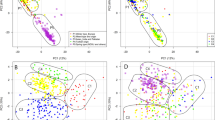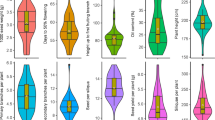Summary
The quantitative consequences of using estimates of additive genetic components of variation from the early generations of a cross to predict the properties of the pure breeding lines extractable from it when there is a linkage disequilibrium are investigated theoretically and by examples drawn from the cross of varieties 1 and 5 of Nicotiana rustica. In the presence of a linkage disequilibrium very good predictions can be obtained by combining estimates of the rank 1 and 2 forms of the additive genetic component of variation which can be estimated from F3 and S3 families of a cross. These predictions can be marginally improved by also estimating the rank 3 form but this requires the addition of F4 families.
Similar content being viewed by others
Article PDF
References
Cooke, P, and Mather, K. 1962. Estimating the components of continuous variation. II Genetical. Heredity, 17, 211–236.
Ingram, N R, and Jinks, J L. 1982. Analysis of induced quantitative variation. II. The recombinant inbred lines. Heredity, 48, 79–83.
Jinks, J L, and Perkins, J M. 1972. Predicting the range of inbred lines. Heredity, 28, 399–403.
Jinks, J L, and Pooni, H S. 1976. Predicting the properties of recombinant inbred lines derived by single seed descent. Heredity, 36, 253–266.
Jinks, J L, and Pooni, H S. 1980. Comparing predictions of mean performance and environmental sensitivity of recombinant inbred lines based upon F3 and triple test cross families. Heredity, 45, 305–312.
Jinks, J L, and Pooni, H S. 1981. Properties of pure breeding lines produced by dihaploidy, single seed descent and pedigree breeding. Heredity, 46, 391–395.
Kearsey, M J, and Jinks, J L. 1968. A general method of detecting additive, dominance and epistatic variation for a metrical trait. I. Theory. Heredity, 23, 403–409.
Mather, K. 1949. Biometrical Genetics (First Edition).Methuen, London.
Mather, K, and Jinks, J L. 1971. Biometrical Genetics (Second Edition) Chapman and Hall, London.
Mather, K, and Jinks, J L. 1982. Biometrical Genetics (Third Edition) Chapman and Hall, London.
Pooni, H S, and Jinks, J L. 1978. Predicting the properties of recombinant inbred lines derived by single seed descent for two or more characters simultaneously. Heredity, 40, 349–361.
Pooni, H S, and Jinks, J L. 1979. Sources and biases of predictors of the properties of recombinant inbreds produced by single seed descent. Heredity, 42, 41–48.
Pooni, H S, Jinks, J L, and Jayasekara, N E M. 1978. An investigation of gene action and genotype × environment interaction in two crosses of Nictoniana rustica by triple test cross and inbred line analysis. Heredity, 41, 83–92.
Virk, D S, Pooni, G S, Ingram, N R, and Jinks, J L. 1981. Analysis of induced quantitative variation. I. Hierarchical and triple test cross analysis. Heredity, 47, 317–326.
Author information
Authors and Affiliations
Rights and permissions
About this article
Cite this article
Jinks, J., Pooni, H. Predicting the properties of pure breeding lines extractable from a cross in the presence of linkage. Heredity 49, 265–270 (1982). https://doi.org/10.1038/hdy.1982.100
Received:
Issue date:
DOI: https://doi.org/10.1038/hdy.1982.100
This article is cited by
-
Genetic control of Asian rust in soybean
Euphytica (2007)
-
Correlated response to selection during selfing
Heredity (1994)
-
Estimation of additive genotypic variance with the F3 of autogamous crops
Heredity (1989)
-
Estimation of the true additive genetic variance ∑ i = 1 k d i 2 in the presence of linkage disequilibrium
Heredity (1986)
-
Comparison of inbred lines extracted from two single crosses and their double cross by single seed descent
Heredity (1986)



